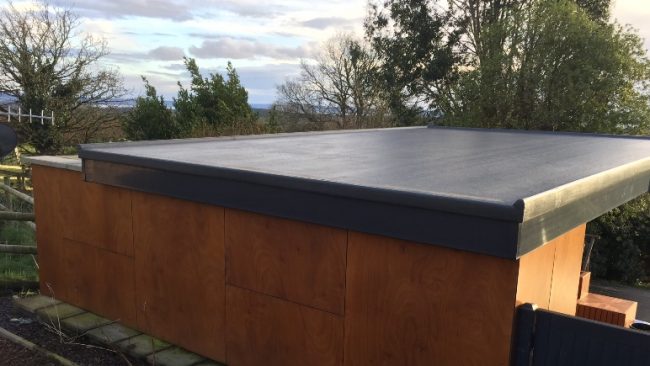Flat roofing
Flat roofing is what it sounds like! A flat roof is level, unlike the majority of roofs that are sloped at an angle. The technical name for the slope of a roof is its pitch, flat roofs have to have a pitch of approximately 10°. The flat roof is an option that has been used for many centuries.
Flat roofing is a popular choice for garages, extensions and modern homes, but can be used for a wide variety of buildings. Flat roofs are typically made using three layers; the insulation, the water proof membrane and the underlay. These three layers keep rain and damp out of a flat roof and protect it from harsh weather conditions.
Materials available for a flat roof
Using the right material for a flat roof is crucial, as the best material will ensure that your flat roof has longevity and reliability. If the material used is not suitable or of poor quality, your flat roof will be vulnerable to the weather. The flat roof membrane needs to be waterproof, strong and flexible.
Roofing Felt –
Roofing felt has been used by flat roofers for centuries. The flat roof membrane is usually made up of asphalt saturated in coal tar pitch. The flat roof sheet is black, but can be manufactured in brown or green. The disadvantage of flat roof felt is that it must be applied at the correct temperature; too hot and it will tear or bubble but too cold and it will not stick flat.
Flat Roof Membrane –
A flat roof membrane is a non-bitumen flat roofing option. It can be made from EPDM rubber, PVC or TPO. The flat membrane has numerous advantages, including being extremely durable and long lasting, as well as being cheaper than felt.
The flat roof membrane has incredible life expectancy; typically between thirty to fifty years; if installed correctly using high quality materials such as diamond coring drill bits.
Coated Fabrics –
Stitched or glued fabrics like polyester and vinyl can be coated with bitumen to make them flat roof membranes. More modern flat roof fabrics such as TPO and EPDM can be uncoated therefore giving much more design freedom when flat roofing a house.
TPO flat roofs are perfect for flat roofs over swimming pools and spas, as they meet the specific flat roof requirements in the building regulations. The flexible nature of these roofs makes them easier to walk on, compared to other flat roofs which tend to feel like walking on an ice rink
EPDM flat roofs are extremely popular; because they allow flat roofs to be built using thinner layers than previous flat roof materials such as rubber and PVC. This makes it possible to use less material during installation which ultimately leads to lower costs.
So which flat roofing material is best for you?
The right flat roofing material for you will depend on a wide range of factors. What type of building is the flat roof on? What is your budget? What is the location of the flat roof?
If you’re simply building a flat roof on your garden shed, it is likely you won’t want to spend a lot of money on it. Felt roofing is likely the best option for a small scale project such as this.
If flat roofing a new build, flat roof membrane is definitely the more popular choice. This flat roofing option will stand the test of time and it durable. The flat roof membrane can be used on flat roofs that are being built for commercial or industrial buildings. Since flat roof membranes are often installed over flat roofs with a steep pitch, these flat roofing professionals will usually use flat roof adhesives to ensure that the flat roof membrane is secure.
Coated flat roof fabrics are most suitable for flat roofs with flat or low-pitched roofs. This type of flat roofing material is easy to install and often costs less than flat roof membranes. This flat roofing should be installed on flat roofs where there isn’t a lot of frequent snow, ice or high winds.
Who to contact about flat roofing
When looking for a company to build your flat roof, Strandek should be at the top of your list of considerations. Strandek have specialised in flat roofing since 1976 and they have been leaders in the industry ever since.
Whatever your project, they are able to provide high-quality flat roofing systems. Whether your project is home or company based, Strandek have the right materials available, ranging from fibreglass to green (sedum) roofing. They will also be able to advise the best option for you.
Before you start building
It is crucial that you do research in to the right material to use for your flat roof before you start the project. If you aren’t getting a professional to build it for you, you might want to consider at least having a conversation with one. You don’t want to spend a lot of money on flat roofing material for it to be pulled off by a strong gust of wind!
